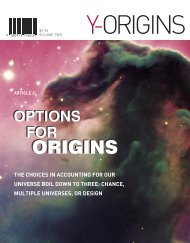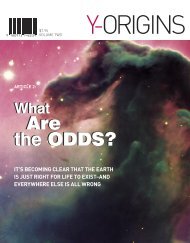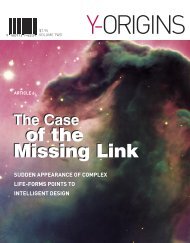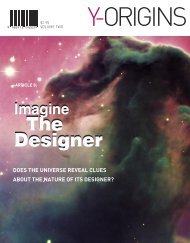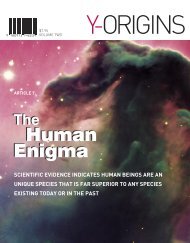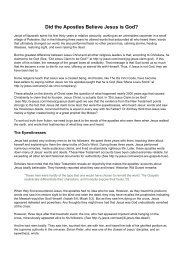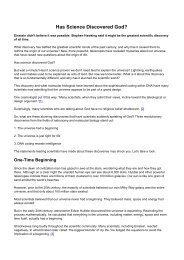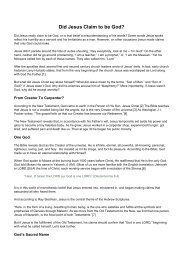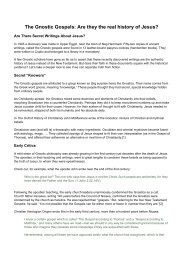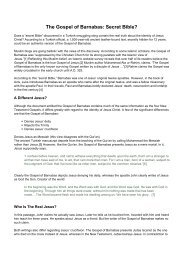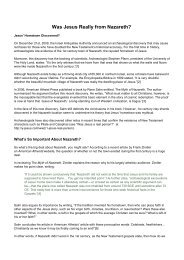Back_to_beginning1
Create successful ePaper yourself
Turn your PDF publications into a flip-book with our unique Google optimized e-Paper software.
RED<br />
SHIFTING<br />
THE<br />
BIG<br />
BANG<br />
THEORY<br />
INTO<br />
HIGH<br />
GEAR<br />
In the late 1920s, the American astronomer<br />
Edwin Hubble noticed something unusual<br />
as he gazed in<strong>to</strong> the heavens. It wasn’t<br />
a new planet or little green men waving<br />
at him from Mars; it was something more<br />
tedious and at the same time more thrilling.<br />
Hubble had been spending countless<br />
nights at the Mount Wilson Observa<strong>to</strong>ry,<br />
studying the stars and galaxies and especially<br />
the spectrum of color in the light they<br />
sent our way. He discovered that the light<br />
from most other galaxies was shifted <strong>to</strong> the<br />
red end of the spectrum, which indicated<br />
they were moving away from us. Furthermore,<br />
the farther a galaxy was away from<br />
us, the more red shifted its light was and,<br />
thus, the faster it was moving away from<br />
us.<br />
The only explanation for all of this was that<br />
space itself was expanding, causing all<br />
galaxies <strong>to</strong> move away from each other. In<br />
an expanding universe, from any point in<br />
space (including our own), it would appear<br />
that most stars and galaxies were racing<br />
away. And the farther away they were, the<br />
faster they would be racing.<br />
There it was in the red shift: proof that<br />
Einstein had been right in the first place<br />
(before he fudged his formula) and that<br />
the universe really was expanding. Proof,<br />
in other words, that the universe was not<br />
eternal but had a beginning. 4<br />
And yet not everyone accepted the proof at<br />
first, including a scientist named Sir Fred<br />
Hoyle (former Plumian professor of astronomy<br />
at Cambridge University and founder of<br />
the Institute of Astronomy at Cambridge).<br />
Ironically, it was Hoyle who originally described<br />
the event as a “big bang,” meaning<br />
<strong>to</strong> mock the idea. The name stuck. (According<br />
<strong>to</strong> physics professor Brian Greene,<br />
the term “big bang” is actually misleading<br />
since there was nothing <strong>to</strong> explode and<br />
no space in which an explosion could take<br />
place.) 5 But unlike Hoyle, many other scientists<br />
began coming over <strong>to</strong> the side of the<br />
newly named theory.<br />
The world’s leading astrophysicist, Stephen<br />
Hawking, who has held the esteemed position<br />
of Lucasian Professor of Mathematics<br />
at Cambridge, calls Hubble’s discovery of<br />
an expanding universe “one of the great<br />
intellectual revolutions of the twentieth<br />
century.” 6 The discovery that the universe<br />
had a beginning has led <strong>to</strong> a new science<br />
called cosmology, which attempts <strong>to</strong><br />
understand what happened at the origin of<br />
the universe, how it works, and what will<br />
happen in its future.<br />
The new science led cosmologists <strong>to</strong> take<br />
another look at a seemingly mundane insight<br />
from the 19th century, the second law<br />
of thermodynamics.<br />
A<br />
SECOND<br />
LAW<br />
OF<br />
FIRST<br />
IMPORTANCE<br />
In addition <strong>to</strong> Hubble’s discovery, the second<br />
law of thermodynamics also predicts<br />
a beginning <strong>to</strong> the universe. You say you<br />
don’t know the second law of thermodynamics?<br />
Think again.<br />
Let’s say you come in<strong>to</strong> a room containing<br />
me and a bunch of your other pals, and you<br />
find a steaming cup of Starbucks coffee on<br />
BACK TO THE BEGINNING • ARTICLE 1 • 7



